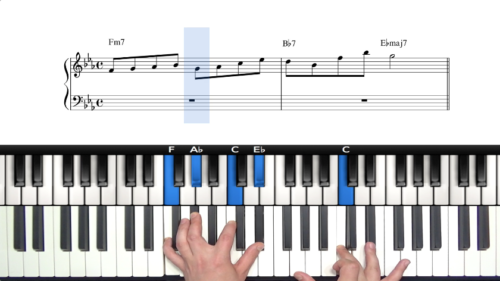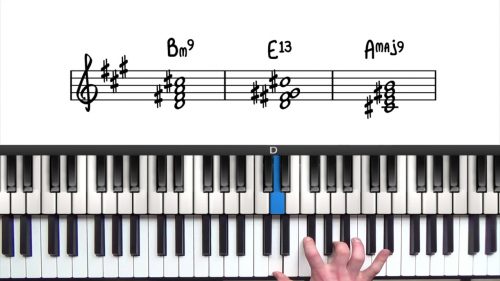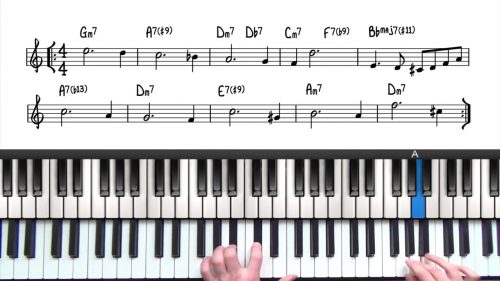Stride Left Hand Style For Ballads
In this lesson we introduce a left hand stride style for the A Section of “Misty”. The stride left hand style drives forward the pulse of the tune and also frees up our right hand for melodic embellishment and decoration and we will explore in the next module on improvisation.
How To Play A Stride Style
To play a stride piano style, our left hand performs 2 roles; it plays the chords and harmony and also establishes the pulse of the tune. We establish the pulse by playing the root notes in the lower registers on beats 1 and 3, and on beats 2 and 4 we play rootless chord voicings.
What Are Rootless Voicings?
Rootless voicings – also known as left hand voicings – are chord voicings where the root is omitted from the chord. This frees up one of our fingers to play more interesting note choices including chord extensions such as the 9th, 11th, or 13th of the chord, or we can play a chord alteration to add tension and colour to our dominant chord voicings.
Rootless Voicings Course
If you are new to rootless voicings, we have a full course on Mastering Left Hand Voicings which includes theory lessons and practice drills to learn these voicings in all 12 keys. You can find these lessons below in the Related Lesson section below.
If this theory is new to you, just copy the voicings that I am showing you in this lesson and you can find a PDF download which contains the exact voicings that I am demonstrating. The full understanding will come with time.
Lesson Downloads
-
Stride Left Hand Voicings File Type: pdf
Practice Tips
-
Move the melody up one octave to create space for the left hand to play the bass and then the rootless chord voicings.
-
Rootless voicings sound best when played as close to the middle C of the piano as possible.
-
Cycle around the 1st bar of Ebmaj7 by playing the root and then the rootless voicing.
-
Next break the 8 bars into smaller chunks and practice these chunks individually by cycling around with left hand isolated.
-
Once you are comfortable with the different sections, add the melody and play the whole 8 bars together.
-
Experiment with changing the chord qualities, in particular changing the minor chords to dominant chords in the 1625 and 3625 progressions.






Is there a download of just the rootless voicing you were playing?
Hi Michael,
The PDF download has been added for this lesson, and also a PDF download for the first 7 lessons in the harmony module.
Cheers, Hayden
Hayden — in the description of adding stride to MISTY you say: ” just copy the voicings that I am showing you in this lesson and you can find a PDF download which contains the exact voicings that I am demonstrating.”
Hayden Where is this PDF found?? Can’t find it?
The PDFs have now been added to the lessons in the harmony module.
The notation for the improv module is coming shortly.
Yes. The pdf would be very helpful.
Hey Wendy 👋
The PDFs downloads have been added to harmony module – you will now see these in the “Downloads” section of each page.
The notation for the improvisation module will be finished shortly.
Cheers, Hayden
The PDF markings, showing both the measures and time stamps for the video, are extremely helpful.
It would be a terrific format for The Nearness of You course.
Yes absolutely the notation with time stamps will be included.
I will shortly post a recording of The Nearness Of You in the community section. It’s the new arrangement I have been working on.
The course will have an intermediate level harmony section, and then an improv section.
Look out for my post in community area over the weekend!
Cheers, Hayden
I noticed on the video when doing the stride chords in the left hand you sometimes use the left hand fingers 4 and 5 together to strike a base note on a black key. Am I imagining this? I have been struggling with the left hand with the pinking finger shaking and not having control. So in observing the video a light bulb went off in my head that I might try this technique and it worked. Is this a common technique? If so, I never noticed it before watching this video
Hi Marco,
Great question!
I just played through “Misty” and you are exactly right with your observation. In fact, when the root note is a black note such as Eb, Bb, Ab, etc… sometimes I play the root note just with my 4th finger, or at least that’s where the main point of contact is between my fingers and the key.
You will see that in your screenshot, my pinky, 4th, and 3rd finger are working as ‘a single unit’ which creates a larger surface area to hit the target bass note. This makes it easier for me to play ‘wider stride’ where my right hand is in the higher octaves as my left hand doesn’t need to have the ‘pin-point accuracy’ when playing the bass note with just my pinky finger.
Whether this is the ‘correct’ technique I’m not sure, but I confirm this is how I play stride.
I wasn’t consciously aware that I was doing this but when I try to play the black notes exclusively with my pinky, it also feels less in control as you mention.
Sometimes my left hand will play root and 5th in the bass, and in those scenarios I am using my pinky and my index finger. I find that playing the root and 5th simultaneously creates a more stable hand position than pinky alone and so that’s also something to experiment with.
Conversely, when the root note is a white note, I do play with the pinky, and I often add the 5th with by index finger to create more stability as mentioned above.
One of the interesting things with jazz and blues music is that musicians who play these styles often develop their own fingering configurations. Unlike classical music, there isn’t a ‘set-in-stone’ fingering that we must stick to.
In addition, the goal in jazz is to eventually create ‘our own sound’ based on our influences which in many ways warrants us to play with the fingering that feels most comfortable for us to create ‘our sound’. For sure there are fingering conventions in jazz, but they are much more flexible than in classical music for example.
I hope that helps Marco.
Experiment with what I mention above and I hope that it helps you to play stride piano more comfortably and confidently.
Please let me know if you have any follow up questions on this and I’m happy to help.
Talk soon, cheers, Hayden
Thank you Hayden!
Your explanation is truly helpful! I will definitely use this technique. I am already using it a bit and I find it helps me to focus less on hitting the correct note and enables me to focus more on creating the sound that I want to hear. All the best, Marco